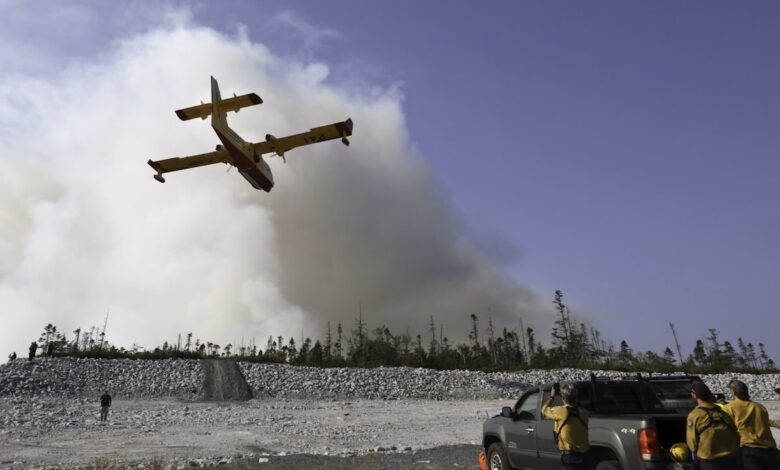Wildfire in Nova Scotias Annapolis Valley Forces Evacations

A water bomber makes a pass on Tuesday about the outfire of Susies Lake in Halifax.H/The Canadian Press
An evacuation warrant in the West-Dalhousie area of the Annapolis valley of Nova Scotia was expanded at the end of Thursday after a lightning strike had lit the night before forests and caused an intense, extraordinary wildfire.
The county of Annapolis expanded the area that was first published under an evacuation warrant that was first published on Thursday morning and covered around 40 houses.
Some residents in the West -Dalhousie Road area had to leave immediately when flames from the Long Lake Fire were moving on in a few kilometers of their houses.
The fire was an estimated four square kilometers in size.
In the province this season, more than 130 forest fires are eliminated in the middle of drought-like conditions, with 11 that are currently burning.
In the meantime, a natural fire on the western edge of Halifax that had led to Wednesday held on Wednesday as the end of Wednesday and was expected to be brought under control on Thursday.
Where in Canada are there warnings for natural fire smoke? Our map follows the air quality throughout the country
The fire in the Annapolis -Valley had grown rapidly at night because the flames reached the tops of the trees, a phenomenon known as a crown.
“The entire tree burns as the flame front progresses,” says Scott Tingley, manager of the Natural Resources Department of Forest Protection. “It is extra challenges in the field of fire suppression.”
Asked if water bombers with fixed wings were brought in to extinguish the flames, Tingley said that there was no available.
Nova Scotia does not have its own fleet of water bombers, which means that it depends on other provinces, such as New Brunswick and Quebec. NOVA Scotia, however, had access to four helicopters that can swing large buckets of water.
“We do our best to coordinate regionally and nationally to see what is available, but there are a number of provinces with very challenging situations,” Tingley told a virtual briefing.
Yet Tingley said that water bombers would probably not have much influence on the Long Lake Fire.
“We could make some progress, but with the nature of this fire – and how fast it grew – it would be doubtful about how effective they would be,” he said. “That fire is intense enough that fixed wing (aircraft) can be at least effective.”
Civil servants said that heavy equipment was brought in to broaden roads and erase brush to protect some structures. Sprinklers are also set up to keep the flames at bay.
On another front, an official said that this fire season was much different than that in 2023, which the province saw suffered by an unprecedented series of forest fires that burned 250 square kilometers of land, destroyed more than 200 houses and was forced to evacuate around 20,000 people.
Jim Rudderham, director of forest protection, said that the fires of 2023 took place in May and June, when the circumstances were not so dry.
“Those fuels are now incredibly dry, all,” he said. “Even large tree stumps, large trunks, everything is extremely dry … Ferries are quickly burning fires that do not usually burn deep. But the fuels are so hot and dry now that these burn … will burn deep and all available fuels will burn.”
Rudderham said that the province needs deeply steeped in rainfall.
“We would take every drop of moisture that we could get, but we need long -term days of steady rain,” he said, adding that the prediction does not look good. In Halifax, where the soil is particularly dry, the prediction on Thursday evening called about five millimeters of rain and on Sunday evening about 10 mm.



